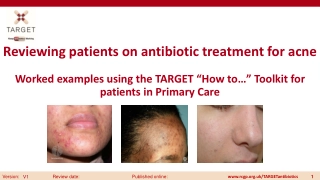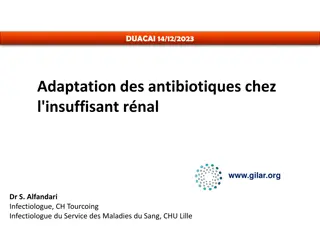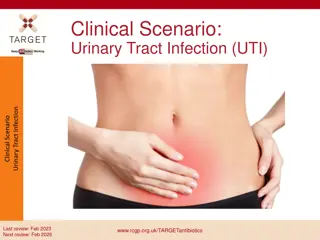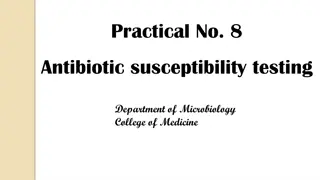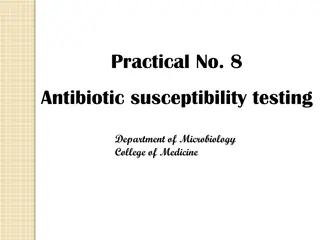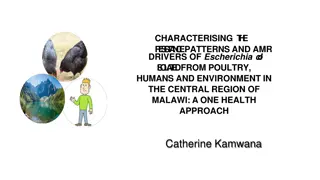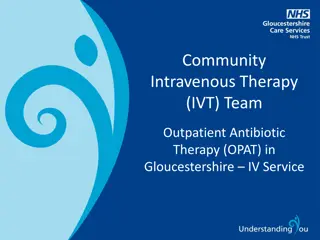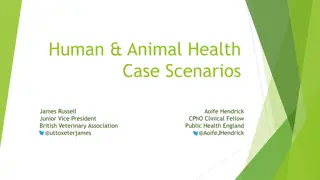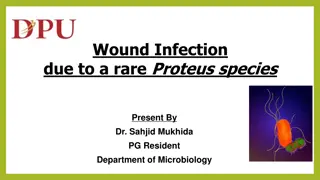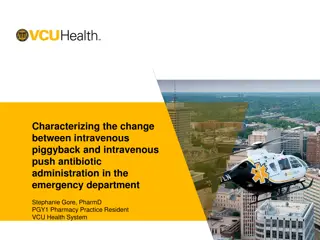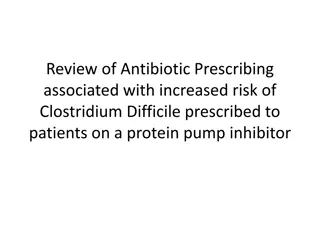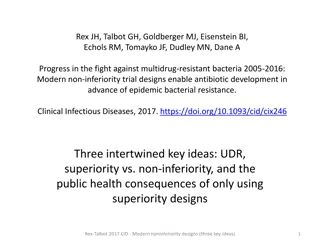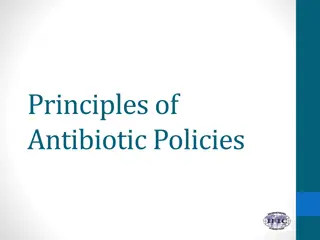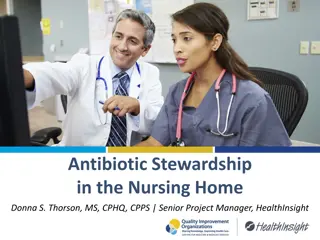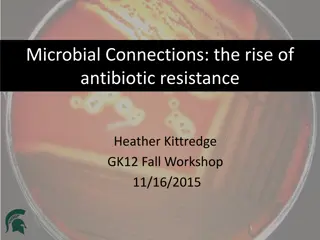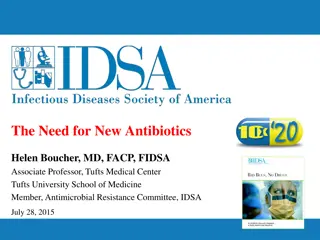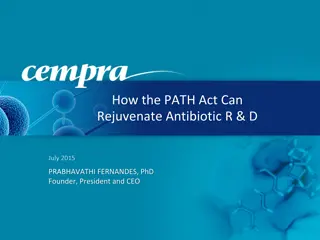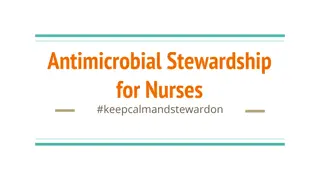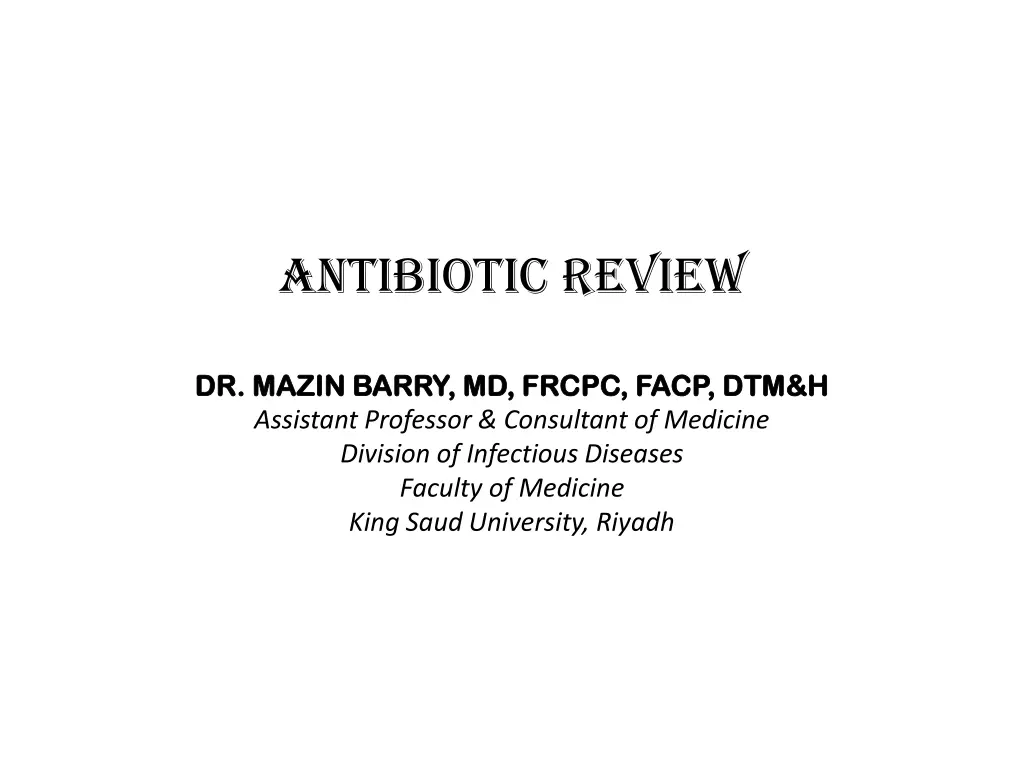
Antibiotic Review and Guidelines by Dr. Mazin Barry - Overview and Usage
Learn about antibiotic usage including prophylaxis, empiric treatment, and definitive therapy as outlined by Dr. Mazin Barry, MD. Understand the general considerations, disease states, bugs, and drugs involved in antibiotic prescribing. Explore the three main ways antibiotics are used and the importance of patient-specific factors in selecting the appropriate treatment. Gain insights into the key principles of antibiotic therapy for different clinical scenarios.
Download Presentation

Please find below an Image/Link to download the presentation.
The content on the website is provided AS IS for your information and personal use only. It may not be sold, licensed, or shared on other websites without obtaining consent from the author. If you encounter any issues during the download, it is possible that the publisher has removed the file from their server.
You are allowed to download the files provided on this website for personal or commercial use, subject to the condition that they are used lawfully. All files are the property of their respective owners.
The content on the website is provided AS IS for your information and personal use only. It may not be sold, licensed, or shared on other websites without obtaining consent from the author.
E N D
Presentation Transcript
ANTIBIOTIC REVIEW DR. MAZIN BARRY, MD, FRCPC, FACP, DTM&H DR. MAZIN BARRY, MD, FRCPC, FACP, DTM&H Assistant Professor & Consultant of Medicine Division of Infectious Diseases Faculty of Medicine King Saud University, Riyadh
GENERAL THINGS TO KNOW THINGS TO KNOW General stuff (Disease States, Bugs, Drugs) Practice - Specific - Local epidemiology (organisms & resistance trends) - Formularies, cost Patient specific - Exposure history, risk factors for specific drugs - Allergies, organ dysfunction, interacting medications, weight, height
THREE WAYS ANTIBIOTIC USED Prophylaxis, Empiric, Definitive PROPHYLAXIS - Medical: ~ Exposure to virulent pathogen - HIV, N. meningitis ~ Immunocompromised - HIV with CD4<200, Asplenic, Neutropenic - Procedural (Surgery) Short course recommended / preferred ~ Endocarditis
THREE WAYS ANTIBIOTICS USED Prophylaxis, Empiric, Definitive (2) Empiric (usually up to 72 hours) - Diagnosis of infection made based on S/S, lab, etc. Likely pathogens suspected but specific pathogen not yet known. - Pick antibiotics based on: = Likely pathogens, local susceptibility trends, and patient-specific factors (allergies, organ dysfunction) -Pearls: = Get cultures on the front end (including special tests) = Start appropriate antibiotics ASAP.
THREE WAYS ANTIBIOTICS USED Prophylaxis, Empiric, Definitive (3) Definitive - Microbiologic or serologic diagnosis with susceptibilities known - Some results to broad-spectrum agents maybe suppressed by lab (cascaded reporting) Call the microbiology lab - Additional testing may be needed (KB or E- test)
THREE WAYS ANTIBIOTICS USED Prophylaxis, Empiric, Definitive (4) Definitive - Use the most effective, least toxic, narrowest spectrum, and most cost effective agent the Drug of Choice (DOC) ~ May actually be a combination of drugs - Ampicillin and Gentamicin for enterococcus endocarditis - Know the alternatives especially for patients with allergy to drug of choice. - Drug, dose, route, interval, and duration is disease state and patient specific.
How Long to Treat? Not well defined! - Usually less than 14 days ~ Longer for endocarditis, Osteomyelitis, Prostatitis (& varies by bug & drugs) - Track number of days of therapy in progress note & set endpoint ~ Coag Neg Staph Bacteremia: 5 7 days ~ Staph aureus Bacteremia: > 28 days (all IV) Prolonged unnecessary therapy increases risk of resistance, adverse effects, and cost
Know Your Bugs Gram - Positive S. aureus: - 25 50% Methicillin Resistant (MRSA) - MSSA DOC: cloxacillin; Cefazolin - CA-MRSA DOC: Vancomycin, Linezolid, Daptomycin ~ If uncomplicated: Trimeth/Sulfa (99%), Clindamycin (70%) Enterococcus: - DOC: (Ampicillin or Vancomycin) PLUS (Gentamicin or Streptomycin) Nitrofurantoin, Amp or Vanc alone for UTI - VRE: linezolid, daptomycin
Know Your Bugs Gram Positive S. pneumoniae: -- 20 45% have decreased susceptibility to penicillin. ~ CNS Infections: High dose (HD) Ceftriaxone (2g IV Q 12h) + HD Vanco ~ Outside CNS: = Ceftriaxone; Respiratory FQ if at risk for resistance = High dose amoxicillin = +/- Doxycycline, TMP / SMX, Erythromycin
Know Your Bugs Gram Negative E. coli, Kleb. pneumoniae ~ 50% resistant to Ampicillin ~ 25% resistant to Trimeth / Sulfa ~ 33% resistant to Ciprofloxacin increase in ESBL DOC carbapenems, less serious Cipro, TMP-SMX, nitro, fosfomycin P. aeruginosa ~ Best Drugs (> 90% susceptible) = Ceftazidime, Cefepime, Piperacillin (with or w/o Tazo) = PLUS an Amikacin for synergy in serious infections ~ Less effective (80% susceptible) = Tobramycin, Gentamicin ~ If C & S verifies susceptibility (65 80% susceptible) = Imipenem, Meropenem, Aztreonam, Ciprofloxacin
Know Your Bugs Gram Negative Bad nosocomial Gram Negative ~ Acinetobacter baumanii = Doc Colistin with meropenem (bleaching effect) +/- Amikacin -Alternative is tigecycline ~ Stenotrophomonas maltophilia (resistant to Imipenem) = DOC Trimethoprin/Sulfamethoxazole (Bactrim) = 10 mg/kg/day of TMP components (2Ds tablets Q12h) Most ICUs have their own flora & susceptibility patterns. Patients become colonized within 48-72 hrs with these bugs
Know Your Bugs Other Bacteria Anaerobes Peptostreptococcus, Clostridium, & Bacteroides - Overall: Amox/Clav, Pip/Tazo, Meropenem, Imipenem, and Tigecycline - Mouth & Lungs: Clindamycin - Abdomen: Metronidazole Atypical Legionella, Mycoplasma, Chlamydia - Macrolides, Tetracycline, Respiratory fluoroquinolones
Know Your Bugs By Mechanism of Action Cell Wall ~ Penicillin Binding Proteins (PBP): Beta-Lactams = Penicillins +/- beta-lactamase inhibitors = Cephalosporins = Others (imipenem, aztreonam) ~ Percursor molecules: Vancomycin Intracellular ~ Ribosomes: Macrolides (5OS), Tetracycline (30S), Aminoglycosides (30S & 50S) ~ DNA gyrase: Quinolones ~ Folate metabolism: Trimethoprim-Sulfa
Know Your Bugs Mechanism of Resistance Altered target PBP s. ~ Absolute Change = no binding = MRSA is resistant to all beta-lactams ~ Relative Change = binding, MIC = Drug resistant S. pneumoniae Enzymes destroy Beta-lactamases ~ Penicillinase: MSSA, H. influenzae, anaerobes = Add beta lactamase inhibitor or change structure ~ Cephalosporinase: Enterobacter et al ~ Extended Spectrum Beta Lactamase (ESBL): Kleb Pneumo, E. coli
Penicillins Penicillin PO, IV & IM = GP (Strep) Amoxicillin PO, Ampicillin IV = GP (Strep), some GNR (70% H. influenzae) Cloxacillin PO, IV = GP (MSSA) Amoxicillin / clavulanate (AUGMENTIN) PO, IV = GP (strep, GNB, Anaerobes) Piperacillin / Tazobactam (Tazocin) IV = GP, GNR (> 90% PA), Anaerobes
GP GN Ana DOC Penicillin Strep None Some Syphilis, Strep Ampicillin Amoxicillin Strep Some Some Enterococcus. Listeria cloxacillin MSSA None None MS SA Amox / clav Strep Some; Great Mixed Community H. Influenzae Pip / Tazo Strep MSSA H. influ. Pa et al Great Mixed Nosocomial
Cephalosporins & Other Beta-Lactams Aztreonam Cephalexin PO Cefazolin IV - Beta-Lactam allergy - GP (MSSA), GNR Cefuroxime - GNR (80% PA) Ceftriaxone IV, IM Imipenem, ertapenem - GP (S. pneumo), Meropenem -GNR - GP (including MSSA) Ceftazidime IV - GNR (> 85% PA) - Anaerobes Cefepime IV - GP (S. pneumo) - GNR (>90% PA) Ceftaroline, IV GP (MRSA) GNR (NOT PA, ESBL) Ceftobibrole: IV GP : MRSA GN: PA - 95% GNR
GP GN Ana DOC Strep MSSA E.Coli None SPPLX SSTI Cefazolin Strep E.coli, Kleb None CAP Ceftriaxone S. Pneiumo Meningitis Poor E coli, Kleb, PA None HAP et al Ceftazidime Strep MSSA Ecoli, Kleb, PA None HAP et al Nosocomial Cefepime Strep MSSA Most including ESBL Great Mixed Nosocomial Imipenem Meropenem None Most GNB (No activity against: serratia, proteus, burkholderia, moraxella, providencia, morganella) None KPC, PDR PA, acinetobacter Colsitin
Beta-Lactam Adverse Effects Allergic / Hypersensitivity in 3 10% of pts. = Rash (4-8%) to anaphylaxis (0.01-0.05%, 10-20 minutes) ~ Carbapenems: 5% cross reactive, Cephs 10% ~ Vasculitis, Cytopenias, Fever, Interstitial Nephritis N/V with PO Seizures w/ high dose in renal insufficiency Ceftriaxone: Biliary sludging and bilirubin displacement (don t use in neonates)
VANCOMYCIN Exclusively Gram-Positive Spectrum - Methicillin Resistant Staph - Ampicillin Resistant Enterococcus - Multi-drug Resistant S. pneumonia - 2ndline for C. difficile Colitis (only indication for PO Vanco) IV only, Check levels & adjust frequency for renal impairment Troughs = 10 20 (15-20 for pneumonia) Peaks = 20-40 (higher in pneumonia) 15 20 mg/kg/dose (1g) IV Q8 12h (Q24h+ for CICr < 60) - Call pharmacy for help with dosing.
QUINOLONES Ciprofloxacin - GNR (75% PA) Levofloxacin, Moxifloxacin - GP (S. pneumo), GNR (respiratory; PA 70% w/ Levo) Cl in pregnancy & children - Rash/photosensitivity, Chelates (PO), CNS side effects, Tendon Rupture QTc prologation, Hypo/Hyperglycemia
AMINOGLYCOSIDES (all IV or IM) Gentamicin, Tobramycin GNR (Tobra > Gent vs. P. aeruginosa) Amikacin, Streptomycin - TB, Multi-drug Resistant GNR Renal elimination, variable penetration in to tissue CNS < 5%, Lungs 50%, Urine 10 100 X Dosing: - Pick dose based on site/bug and interval per renal function (GFR < 60). - OD for GNR, MDD for GP Nephrotoxicity (non-oliguric) & Ototoxic Prolonged exposure to elevated levels (troughs >2).
Macrolides & Lincosamides Erythromycin GP (Strep) & Atypicals GI side effects and inhibits CYP450 = drug interactions Azithromycin IV, PO Clarithromycin PO - GP (Strep), Atypicals & Respiratory GNR; non tuberculous Mycobacterium Clindamycin (all PO, IV) - GP (GP 75% MRSA), Anaerobes - AE: C. difficile colitis
Other Antibacterials Tetracycline PO, Doycyclne PO & IV - GP, GN, Atypicals; Brucella - Binds orally with calcium deposits on teeth, photosensitivity Trimethoprim / Sulfamethoxazole - GP ( MSSA & MRSA), GNR - Rash and other ADE s, Drug interactions with warfarin Metronidazole - Anaerobes & Protozoa - Reactions with EthOH, Metallic taste, drug interactions with warfarin Nitrofurantoin - UTI (including VRE) - Contraindicated at GFR < 60
Know your Drugs Pharmacodynamics Pharmacodynamics (PD) - Bacteriostatic: Inhibit ~ Generally avoid for endocarditis, meningitis, osteomyelitis, and febrile neutropenia ~ Tetracyclines, Macrolides, TMP / SMX, Linezolid - Bacteriocidal: Kill ~ Dose dependent (Peak:MIC > 10) - Aminoglycosides, Quinolones ~ Exposure dependent (T >MIC) - Beta lactams, vancomycin
Know your Drugs Absorption: IV vs PO - Great PO absorption with fluoroquinolones (watch drug interactions), Metronidazole, TMP/SMX, doxycycline. - IV only: ~ Vancomycin (except for C. difficile) ~ All antipseudomonal agents except ciprofloxacin ~ some cephalosporins (advanced generation) ceftriaxone IM for GC ~ Meropenem, Imipenem, ertapenem (IM available) and Aztreonam ~ Aminoglycosides (gentamicin) - may give small dose IM
Know Your Drugs DISTRIBUTION CNS Penetration: - Excellent: Metronidazole, chloramphenicol, fluconazole, TB drugs - Adequate with high doses: Ceftriaxone, ceftazidime, ampicillin - Problematic: Vanconmycin, aminoglycosides - Lungs: - Good: quinolones, Macrolides, beta-lactams - Modest: aminoglycosides
Know Your Drugs Metabolism / Elimination - Kidneys - Adjust for renal dysfunction (Cl Cr) - May use lower doses for UTI - Liver - Rare adjust for liver dysfunction - Potential for drug interactions
Drug Interactions Drugs cleared by CYP 450 Statins, Cyclosporine, Benzodiazepines, Theophylline, Anticonvulsants, oral hypoglycemic - Levels increase by (Metabolism inhibited by) Macrolides (Erythromycin) Azoles (Fluconazole, Itraconazole) Protease inhibitors Ciprofloxacin - Levels decreased by (Metabolism induced by) Rifampin Oral Contraceptives - Decreased with rifampin & cloxacillin
Drug Interactions Warfarin: - Effect & INR profoundly increased by trimethoprim/sulfamethoxazole metronidazole - Significant increase with fluconazole, Ciprofloxacin - Decreased by Rifampin Multivalent Cations (Ca, Mg, Iron) - Decreases absorption of: Fluroquinolones Tetracyclines
ANTIBACTERIAL PHARMACODYNAMIC CHARACTERISTICS Class Mechanism of Action Concentration vs Time Dependent Activity Bactericidal vs Bacteriostatic Activity Mechanisms of Resistance Antibacterial Agents B-Lactams Altered PBP (MRSA, PRSP) B-Lactamase production (PPNG; TEM and SHV-producing organisms; ESBL- producing K. pneumonia and E. coli; AmpC gene induction in Enterobacter, Citrobacter, Morganella, Providentia, Serratia, and Pseudomonas species) Penicillins Inhibition of PBP activity resulting in peptidoglycan layer synthesis in cell wall Time Cidal Cephalosporins (e.g., cefazolin) Time Cidal Loss of outer membrane porin channels for entry (Pseudomonas aeruginosa) Carbapenems (e.g., imipenem) Time Cidal Ionic interaction with cell wall Disruption of protein synthesis of 30S ribosomal subunit via codon misreading Production of aminoglycosides modifying enzymes (acetylases, adenylases, phosphorylases) resulting in drug inactivation 30S ribosomal mutation Decreased membrane permeability Aminoglycosides (e.g., gentamcin) Conc Cidal Altered binding site due to mutation in DNA gyrase and/or topoisomerase IV Active efflux pump Fluoroquinolones (e.g., ciprofloxacin) Inhibition of DNA gyrase and topoisomerase IV activity Conc Cidal
ANTIBACTERIAL AND ANTIFUNGAL CHARACTERISTICS (CONT D) ANTIFUNGAL PHARMACODYNAMIC Bactericidal vs Bacteriostati c Activity* Concentration vs. Time Dependent Activity Class Mechanism of Action Mechanisms of Resistance Ligase conversion of D-ALA-D-ALA to D-ALA-D lactate which prevents vancomycin binding Glycopeptides (e.g., vancomycin) Binding to D-ALA-D-ALA terminus complex in peptidoglycan layer of cell wall to inhibit PBP binding & activity Time Cidal 23S Ribosomal subunit methylation by erm gene products Active efflux (e.g., efflux pump from msr gene inducton in S. aureus or from mef induction in S. pneumonia or S. pyogenes) Macrolide modification or inactivation Macrolides (e.g., erythromycin) Binding to 50S ribosomal subunit and interruption of protein synthesis via transpeptidation or translocation inhibition Time Static (Azithromycin Conc) Nitroimidazoles e.g., metronidazole Toic free radical formation Conc Cidal Unclear / uncommon Oxazolidinones (e.g., linezolid) Disruption of protein synthesis at 30S/50S ribosomal subunits Time Static (cidal to streptococci) Ribosomal binding site alteration Streptogramins (e.g., quinupristin/ Dalfopristin) Binding to 50S subunit of ribosome resulting in inhibition of peptide chain elongation and peptidyl transferase activity; quinupristin and dalfopristinare synergistic Time Cidal (staphylococci, streptococci, Enterococcus faecium) 23S Ribosomal subunit methylation by erm gene products (MLSB resistance) Active efflux Enzyme inactivation Static (Enterococcus faecalis)
ANTIBACTERIAL AND ANTIFUNGAL PHARMACODYNAMIC ANTIBACTERIAL AND ANTIFUNGAL PHARMACODYNAMIC CHARACTERISTICS (CONT D) CHARACTERISTICS (CONT D) Concentration vs. Time Dependent Activity Bactericidal vs Bacteriostatic Activity* Class Mechanism of Action Mechanisms of Resistance Lincomycins (e.g., clindamycin Disruption of protein synthesis at 50S ribosomal subunit via inhibition of amino acid linking Time Static 23S ribosomal mutation/methylation (MLSB resistance) Rifamycins (e.g., rifampin Binding interference at 30S ribosomal subunit / mRNA complex binding interference Time Static Single step mutation in - subunit of DNA-dependent RNA polymerase (e.g., S. aureus) Tetracyclines Binding to 30S ribosomal subunit and disruption of protein synthesis at 50S subunit via inhibition of amino acid linking Conc Static Decreased uptake Active efflux pump Disruption of folate synthesis; DNA synthesis Sulfa (e.g., sulfamethoxazole/trim ethoprim Conc Static Production of new dihydrofolate reductase and dihydropteroate synthetase PABA Decreased membrane permeability Antifungal Agents Uncommon Decreased ergosterol cell membrane content (e.g., via previous azole use) Polyenes (e.g., amphotericin B) Disruption of cell membrane via intercalation with sterols, disrupting cell integrity Cidal * Nature of activity at recommended doses against usual pathogens
ANTIBACTERIAL AND ANTIFUNGAL PHARMACODYNAMIC ANTIBACTERIAL AND ANTIFUNGAL PHARMACODYNAMIC CHARACTERISTICS (CONT D) CHARACTERISTICS (CONT D) Concentration vs. Time Dependent Activity Bactericidal vs Bacteriostatic Activity* Mechanisms of Resistance Class Mechanism of Action Modification of cytochrome P450- dependent 14a- demethylase Active efflux pumps Azoles (e.g., fluconazole) Disruption of fungal sterol synthesis via inhibition of cytochrome P450- dependent 14a- demethylase which is required for conversion of lanosterol to ergosterol Static Common, especially if agent used alone 5-Flucytosine Cellular conversion to 5- fluorouracil, a false pyrimidine, and subsequent interference with DNA and protein synthesis Inhibition of -1, 3- glucan synthetase resulting in disruption of cell membrane synthesis Cidal Unknown Echinocandins (e.g., caspofungin) Cidal (Candida species) PBP = penicillin-binding proteins MRSA = methicillin-resistant Staphylococcus aureus PRSP = penicillin-resistant Streptococcus pneumonia PPNG = penicillin-producing Neisseria gonorrhoeae ESBL = extended-spectrum -lactamase D-ALA = D-alanine PABA = para-aminobenzoic acid

